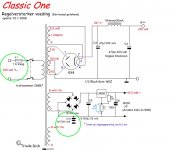Hello DIY,
Two Quick questions on this PSU Build
I have circled in green on the PSU schematic image: what Im referring to
Question 1:
C10: 1uF/250V Capacitor after the bridge rectifier:
I'm unfamiliar with this being there, is it some sort of bleeder/filtering device?
It goes straight to ground and its voltage rating is so high (DC/AC)?
Is there a part recommendation i can use for this? -
I have a few of these in my parts bin:
QXK2J105KTP | Nichicon 1μF Polyester Capacitor PET 250 V ac, 630 V dc +-10% XK Series Radial | RS Components
Question 2:
I have the transformers
I noticed they are 230v (where as, in Australia we have 240V AC mains)
I connected them and they work fine, but the power higher on all the secondaries as a consequence....the only reason this bothers me is i know that BIAS is real important in this project,
I know it is no big deal with the regulated heater cct.
But the Tube Rectifier and the supply going to the Amp Valves will be higher Volt - Maybe under load this does not matter? Or it is easy fix with a resistor in series??
If you would like me to clarify anything more please let me know also!
Here is the links of the Full Build and PDFs ect
http://www.triodedick.com
http://www.triodedick.com/classic_1/classic_one_schema_versterker.GIF
http://www.triodedick.com/classic_1/classic_one_schema_voeding.GIF
Two Quick questions on this PSU Build
I have circled in green on the PSU schematic image: what Im referring to
Question 1:
C10: 1uF/250V Capacitor after the bridge rectifier:
I'm unfamiliar with this being there, is it some sort of bleeder/filtering device?
It goes straight to ground and its voltage rating is so high (DC/AC)?
Is there a part recommendation i can use for this? -
I have a few of these in my parts bin:
QXK2J105KTP | Nichicon 1μF Polyester Capacitor PET 250 V ac, 630 V dc +-10% XK Series Radial | RS Components
Question 2:
I have the transformers
I noticed they are 230v (where as, in Australia we have 240V AC mains)
I connected them and they work fine, but the power higher on all the secondaries as a consequence....the only reason this bothers me is i know that BIAS is real important in this project,
I know it is no big deal with the regulated heater cct.
But the Tube Rectifier and the supply going to the Amp Valves will be higher Volt - Maybe under load this does not matter? Or it is easy fix with a resistor in series??
If you would like me to clarify anything more please let me know also!
Here is the links of the Full Build and PDFs ect
http://www.triodedick.com
http://www.triodedick.com/classic_1/classic_one_schema_versterker.GIF
http://www.triodedick.com/classic_1/classic_one_schema_voeding.GIF
Attachments
Last edited:
5% higher voltage won't matter. Heater voltage is regulated, though you might check the rectifier's heater voltage - a small resistor can be added if necessary.
Heater supply has the 1 uF for an AC ground connection, to filter common-mode noise (coupled through primary-to-secondary capacitance). A 100V cap would do, anything higher is fine.
Heater supply has the 1 uF for an AC ground connection, to filter common-mode noise (coupled through primary-to-secondary capacitance). A 100V cap would do, anything higher is fine.
